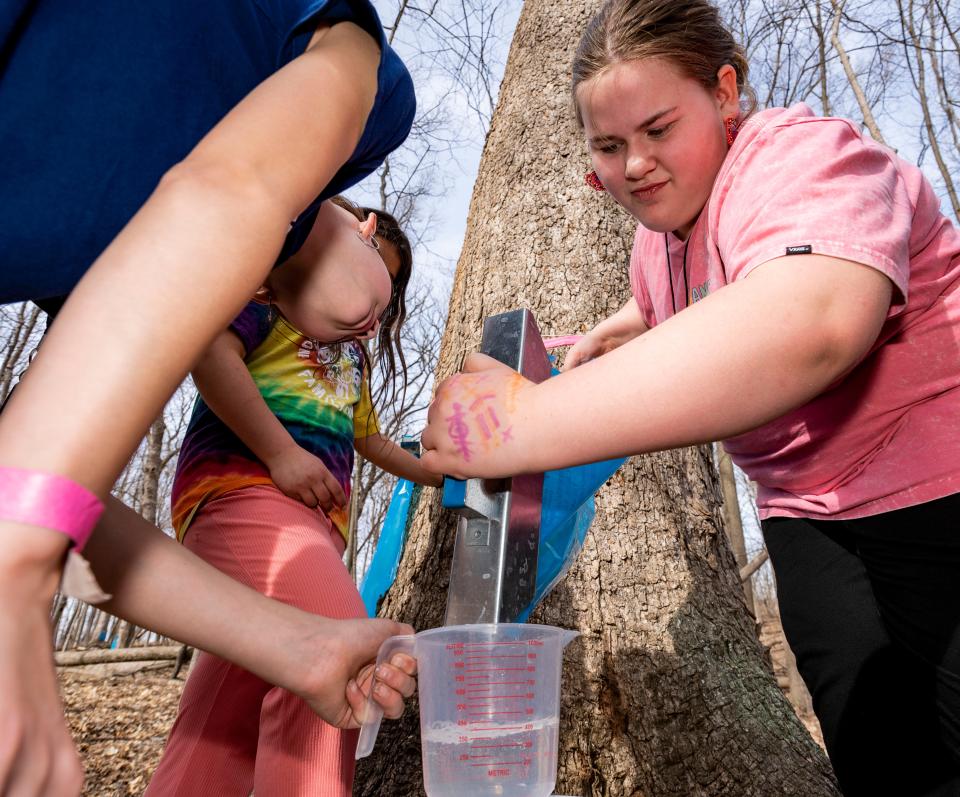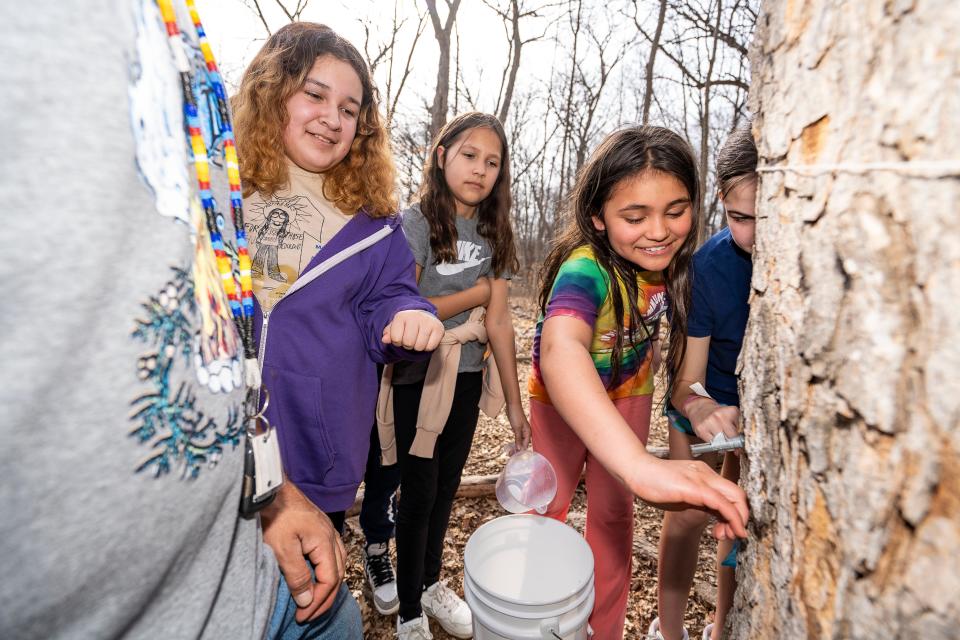Tribal students in Franklin learn how to tap maple trees like their ancestors
FRANKLIN – About a dozen fifth-grade students crowded around Michael DeMain and a 175-year-old maple tree in the forest preserve surrounding the Wehr Nature Center in Franklin, eager to collect sap on a warm late February afternoon.
The children use their math skills to add up the number of cups of the sweet liquid they collect.
As they finish, one child exclaims, “Thanks, tree!”
Maple tapping season, a tradition started by Indigenous peoples, is upon us, but it can be difficult for tribal families in the Milwaukee area to practice this part of their heritage.
The students who were learning about maple tapping from DeMain have tribal heritage and attend the Indian Community School in Franklin.
The school was started in 1969 by three Milwaukee-area Oneida mothers who pulled their children out of the Milwaukee Public Schools and started teaching them in an apartment living room with an Indigenous educational approach.
Today, the school serves more than 300 Indigenous students representing more than 30 tribes from across North America, or Turtle Island.
Its mission remains the same, to provide an Indigenous American education with a special emphasis on teaching Indigenous history, culture, language and practices.
Maple tapping has been an Indigenous peoples practice this time of year for thousands of years. It's something that educators at the Indian Community School don’t want Native families in the Milwaukee area to forget.
“This is not something these children can usually get to do around here, unless they can get back to the reservation,” said Siobhan Marks, communications director for the school.
“This gives urban Native kids a chance to experience what their ancestors did every winter.”
The Indigenous peoples of Turtle Island had taught the first European colonizers how to tap the maple tree and make maple sugar or syrup, according to historians.

“The (maple sugar) camp is fun because we’re learning about our culture,” said 11-year-old Waazakone OzaaWigwan.
She said the raw maple sap tasted like sugar water.
The children started their camp by meeting with DeMain at the Wehr Nature Center.
DeMain, who’s a member the Lac Courte Oreilles Ojibwe Tribe in northern Wisconsin, started by telling an ancient Ojibwe story about maple syrup.
According to legend, the maple syrup once flowed freely and ready to eat from maple trees every late winter and early spring.
So, the Ojibwe people had gorged themselves on the syrup and started to grow fat and lazy because they didn’t have to work for it.

It was then that Wenaboozho, the Ojibwe folk hero, first man and trickster, decided to dilute the syrup into sap, so people would have to work to refine it.
DeMain took the children into the forest, where the eighth-graders the day before had already drilled holes for a spigot for the sap to run through. Before they had tapped the tree, they offered asemaa, or ceremonial tobacco, to give thanks to Creator for providing sap.
Then they tapped a hole between an 1½ and 2 inches deep, making sure there was no bark in the hole.
DeMain explained to the fifth-grade students the next day that it’s best for the tree to be tapped on its sunny, or south, side. That’s where the sap runs best.
The sap is then collected into buckets or bags attached to the tree that the children gathered and measured.
They then carried the buckets to a campfire about 100 yards away, where they would pour the sap into a large cauldron to be boiled down.
Forty gallons of sap boils down to about 1 gallon of maple syrup.

The Wehr Nature Center also offers maple sugar camps for non-tribal students.
With about 250,000 gallons of maple syrup produced every year, according to the Wisconsin Maple Syrup Producers Association, the state is the fourth-largest producer in the United States behind Vermont, New York and Maine.
In Wisconsin, there are more than 2.2 billion maple trees that are at least 4½ feet tall, according to the Department of Natural Resources, with more than 863 million sugar maples.
A maple tree must be at least 10 inches in diameter before considering tapping because the sap runs through its third layer. Tapping doesn't cause harm to the tree, because it can respond by sealing the hole and be ready for tapping again the next year in a different area.
Marks said there are young maple trees that have been planted on the property of the Indian Community School.
But it will be between 10 and 15 years before they can be tapped, so Marks said school officials have formed a partnership with the Wehr Nature Center for the time being.

Sign up for the First Nations Wisconsin newsletter Click here to get all of our Indigenous news coverage right in your inbox
Frank Vaisvilas is a former Report for America corps member who covers Native American issues in Wisconsin based at the Milwaukee Journal Sentinel. Contact him at fvaisvilas@gannett.com or 815-260-2262. Follow him on Twitter at @vaisvilas_frank.
This article originally appeared on Milwaukee Journal Sentinel: Milwaukee area tribal students learn how to tap maple trees

